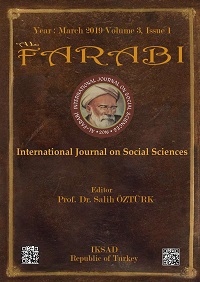AFYONKARAHİSAR PEŞKİR DOLAMALARI
Anahtar Kelimeler:
Peşkir Dolamaları, Uzun Peşkir, Afyonkarahisar, El Dokuması Kumaş, İşlemeÖzet
Türk kültürünün zenginliği gelenek ve göreneklerde, el sanatlarının çeşitliliğinde görülmektedir. Özel ve günlük yaşamda eşyalar hem kullanım hem de sanatsal anlamda birbirini tamamlamaktadır. Geleneksel sanatlar içinde yer alan halı, kilim, giyim-kuşam ve daha birçok alanda üretilen el sanatlarında ilk önce kullanım amacı önemli olmuştur. İnsanların süslenme isteğiyle bu ürünlerin sanatsal gelişimi gerçekleşmiştir. Geleneksel sanatlar içinde dokuma, işleme açısından önemli bir yere sahip olan peşkirler ve peşkir dolamaları yemek esnasında elleri temiz tutmak amacıyla ortaya çıkmış, Türk insanının ince zevkiyle süslenerek seçkin etnografik eserler içinde ki yerini almıştır. Halk arasında peşkir sözü, 1 ya da en fazla 3 kişinin kullanabildiği, peşkir dolamaları sözü ise 12 kişinin aynı anda sofrada kullanabildiği dokumalar için kullanılmıştır. Tarihi geçmişinde birçok uygarlığı barındıran, Anadolu’nun kavşak noktası Ege Bölgesi’nin iç kısmında yer alan Afyonkarahisar zengin mutfak kültürü ve misafir ağırlamayı sevmesiyle dikkat çekmektedir. Davet yemeğinde sofraya oturan davetliler dizlerinin üzerine uzun peşkirleri yerleştirir, ellerini bu peşkirlere silerdi. Afyonkarahisar peşkir dolamalarının dokunmasında pamuk ve keten ipliği kullanılmıştır. Uzun peşkirler, evlerde, dokumacılığı geçim kaynağı haline getirmiş kişiler tarafından, el tezgahlarında istenilen en ve boyda dokunurdu. Genellikle meydan sofralarında kullanılacağı için, 12 kişinin aynı anda dizlerini örtecek boyutlarda dokunmuştur. Peşkir dolamalarının iki kenarı değişik işleme teknikleri kullanılarak süslenmiştir. Bu işlemelerde birçok iplik türü, sırma ve tel şeritler kullanılmıştır. Peşkirlerin iki ucuna değişik teknikler kullanılarak yapılan işlemelerde birçok motif tek ya da bordür oluşturacak biçimde uygulanmıştır. Artık müze ve aile koleksiyonlarında gördüğümüz peşkir dolamalarının Afyonkarahisar kültüründeki yeri, dokuma, işleme ve desen özellikleri, çalışmada ayrıntılı verilmiştir. Ayrıca bu konuda çalışacak araştırmacılara yazılı kaynak sağlamak ve gelecek kuşaklara elde edilen bilgi birikimini aktarmak araştırmanın amacını oluşturmaktadır.




